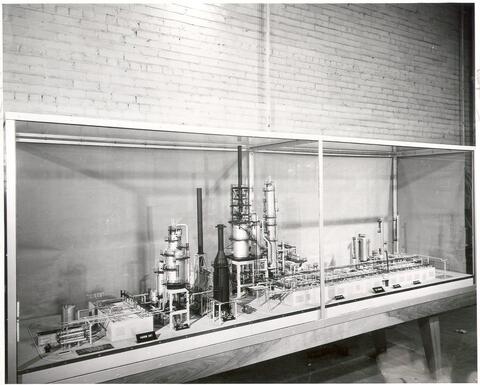
Title and statement of responsibility area
Titel
Petroleum Engineering - "Cat Cracker" Model
Algemene aanduiding van het materiaal
- Graphic material
Parallelle titel
Overige titelinformatie
Title statements of responsibility
Titel aantekeningen
Beschrijvingsniveau
Stuk
archiefbewaarplaats
referentie code
Editie
Editie
Edition statement of responsibility
Class of material specific details area
Statement of scale (cartographic)
Statement of projection (cartographic)
Statement of coordinates (cartographic)
Statement of scale (architectural)
Issuing jurisdiction and denomination (philatelic)
Datering archiefvorming
Datum(s)
-
1955 (Vervaardig)
Fysieke beschrijving
Fysieke beschrijving
1 photograph : b&w ; 20 x 24 cm
Publisher's series area
Title proper of publisher's series
Parallel titles of publisher's series
Other title information of publisher's series
Statement of responsibility relating to publisher's series
Numbering within publisher's series
Note on publisher's series
Archivistische beschrijving
Naam van de archiefvormer
Geschiedenis beheer
Bereik en inhoud
Image of a cat-cracker-model relating to Petroleum Engineering.
Aantekeningen
Materiële staat
Directe bron van verwerving
Ordening
Taal van het materiaal
Schrift van het materiaal
Plaats van originelen
Beschikbaarheid in andere opslagformaten
Restrictions on access
Termen voor gebruik, reproductie en publicatie.
Photographer: Saskatoon Star-Phoenix
Copyright: Saskatoon Star-Phoenix
Toegangen
Associated materials
Aanvullingen
Algemene aantekening
From Star-Phoenix article on back of image: "Petroleum Engineering - a new branch in the College of Engineering - is being introduced at the University of Saskatchewan for the 1955-1956 term. The new branch will take its place along with the other seven branches of engineering: agricultural, chemical, civil, electrical, geological, mechanical and engineering physics. The university's first appointment in the branch is assistant professor R.B. Shearn, a graduate of the University of Birmingham. The course is designed for the student intending to engage in the engineering phases of the production of oil and gas, rather than the exploration and geological work to do with the searching and development of oil and gas fields. Students who have satisfactorily completed the third year in chemical engineering or geological engineering will be admitted to a final fourth year in petroleum engineering. Because of the differences in the first three years of training, part of the work will differ for the two groups. Both will, on graduation, have a similar amount of engineering training, but one will have a broader knowledge of chemistry and the other of geology. Either is quite satisfactory for this field of engineering and allows for later specilization, if desired. Imperial Oil Ltd. presented a model of a modern oil refinery to the engineering college in November. The model is of the latest fluid catalytic cracking unit and vacuum distillation unit of the Regina plant. The model is built on a scale of 1/4 inch to the foot. It measures six feet by twwn feet and is approximately four feet high. These units formed the magjor part of an expansion program which was two years in the building and cost more than $7 million. The model is valued at $5,000. The model travelled to Saskatoon in a special moving van on a six-inch thickness of felt padding. On top of this were inflated rubber tubes, covered by a 700 pound sheet of boiler plate. On top of it were more pads and a huge sheet of sponge rubber. The model sat on a wooden frame and was held down by robes attached to large coil springs. Old tires were placed between the walls of the van and the model. These precautions were necessary to prevent the vibration from shaking the balsa wood and plastic to pieces. The high towers of the model were braced with wood, heavy cord and adhesive tape. The model is not a show piece but for practical demonstration purposes in the college."

